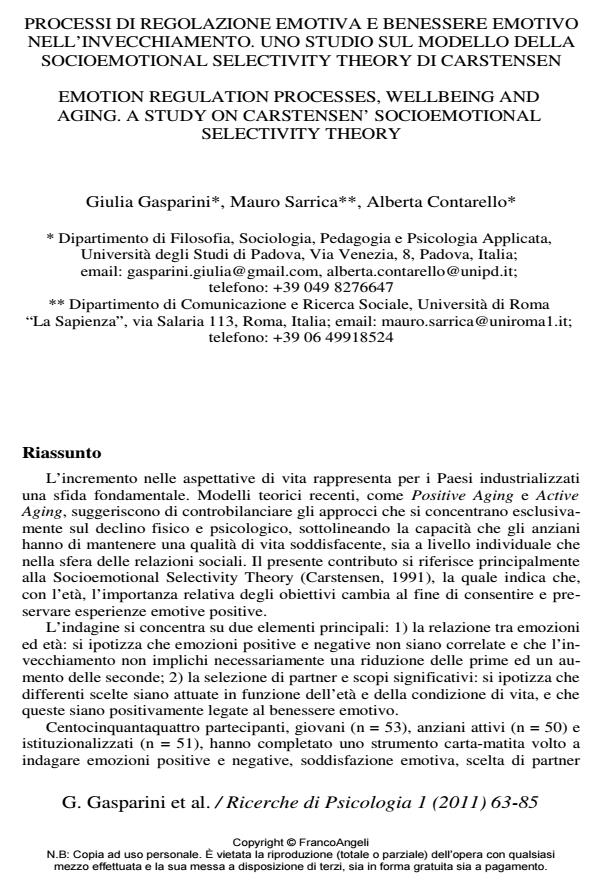Emotion regulation processes, wellbeing and aging. a study on Carstensen’ socioemotional selectivity theory
Journal title RICERCHE DI PSICOLOGIA
Author/s Giulia Gasparini, Mauro Sarrica, Alberta Contarello
Publishing Year 2012 Issue 2011/1
Language Italian Pages 23 P. 66-85 File size 177 KB
DOI 10.3280/RIP2011-001004
DOI is like a bar code for intellectual property: to have more infomation
click here
Below, you can see the article first page
If you want to buy this article in PDF format, you can do it, following the instructions to buy download credits

FrancoAngeli is member of Publishers International Linking Association, Inc (PILA), a not-for-profit association which run the CrossRef service enabling links to and from online scholarly content.
With increased life expectancy, industrialized countries are facing a main challenge. Recent theoretical models, such as Positive Aging and Active Aging, counterbalance views that focus on physical and psychological decline linked with aging, and stress the ability elders have to maintain a satisfying quality of life both at the individual level and in the sphere of social relationships. The current paper refer to the Socioemotional Selectivity Theory (Carstensen, 1991) which states that, with age, the relative importance of specific goals would change to provide positive emotional experiences. The present study focuses on two main points: 1) the relation between emotions and aging; positive and negative emotions are expected not to be correlated, aging is expected not to imply a reduction of positive emotions and a consequent increase of negative ones; 2) the selection of significant partners and social goals; different choices are expected in function of age and life conditions, and should be positively related to emotional well-being. One hundred fifty-four participants, young (n = 53), active elderly (n = 50) and institutionalised elderly (n = 51), answered a paper-and-pencil instrument in order to measure positive and negative emotions, emotional satisfaction, choice of social partners, and goals. Coherently with the model, main results indicate independence of positive and negative emotions. Moreover elders do not indicate a decrease in positive emotions. They show lower levels of rage and anxiety than youth, instead. Moreover, active elderly and youth show similar response patterns. However, differently from SST expectations with the increase of age, giving importance to social aims favours in itself emotional well-being. Results indicate the need to deepen aging process not only in relation with life expectancy but also with life-styles.
Keywords: Aging, emotional well-being, emotion regulation processes, Socioemotional Selectivity Theory.
Giulia Gasparini, Mauro Sarrica, Alberta Contarello, Processi di regolazione emotiva e benessere emotivo nell’invecchiamento. uno studio sul modello della socioemotional selectivity theory di Carstensen in "RICERCHE DI PSICOLOGIA " 1/2011, pp 66-85, DOI: 10.3280/RIP2011-001004